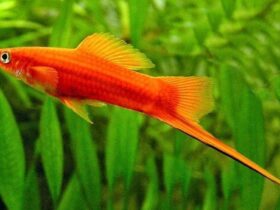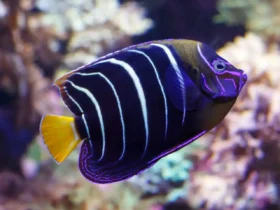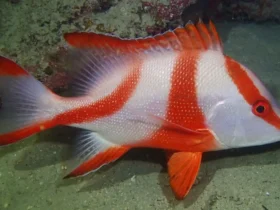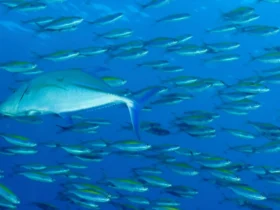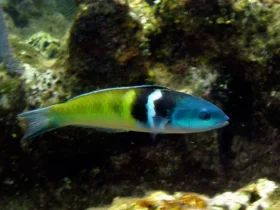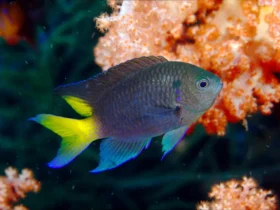The Candy Basslet (Liopropoma carmabi) is a small but strikingly beautiful reef fish that inhabits the warm waters of the Caribbean Sea. With its vibrant colors, unique patterns, and charming personality, the Candy Basslet has become a highly sought-after species among aquarists and diving enthusiasts. In this article, we will explore the captivating world of the Candy Basslet, uncovering its appearance, behavior, habitat, and the importance of conservation efforts to protect its fragile marine ecosystem.
Appearance and Coloration
The Candy Basslet is renowned for its remarkable and vivid coloration. It features a deep, vibrant purple to magenta body that contrasts beautifully with its bright yellow fins and electric blue markings. These colors make it appear as if it were crafted from a palette of candy hues, hence its popular name. Its large, round eyes and elongated, slender body contribute to its overall allure and elegance.

Habitat and Distribution
Candy Basslets are native to the warm waters of the Caribbean Sea, specifically found in the region stretching from Florida to Venezuela. They inhabit coral reefs and rocky areas, typically dwelling in depths ranging from 30 to 100 feet (9 to 30 meters). These colorful fish seek shelter among the crevices and coral formations, where they find protection and suitable feeding grounds.
Behavior and Feeding
Candy Basslets are relatively peaceful and social fish. They are known to form small groups or pairs, often seen swimming near the reef or darting between corals. Despite their small size, they exhibit territorial behavior, defending their preferred spots within the reef. Their diet primarily consists of small invertebrates, including tiny crustaceans and zooplankton that inhabit the reef ecosystem.

Reproduction and Life Cycle
During the breeding season, Candy Basslets engage in courtship displays to attract a mate. The male intensifies its vibrant coloration and displays courtship behavior, such as fin flaring and rapid swimming. Once a pair is formed, they engage in an elaborate spawning ritual, releasing eggs into the water column. After hatching, the larvae undergo a pelagic phase before settling in coral reef habitats as juveniles.
Conservation and Protection
The Candy Basslet is not currently listed as endangered, but its survival is closely tied to the health and conservation of coral reef ecosystems. The threats that these habitats face, including overfishing, pollution, climate change, and destructive fishing practices, put the Candy Basslet and numerous other marine species at risk. Conservation efforts that focus on protecting coral reefs and promoting sustainable fishing practices are crucial to ensure the long-term survival of this stunning species.

Aquarium Care
Due to its vibrant colors and small size, the Candy Basslet has become a popular choice for saltwater aquarium enthusiasts. However, it is important to note that proper care and consideration are required to meet its specific needs. Maintaining stable water parameters, providing suitable hiding spots within the aquarium, and offering a varied diet that includes quality marine foods are essential for the well-being of this delicate fish.
- Royal Gramma (Gramma loreto): The Royal Gramma is one of the most well-known and popular Candy Basslet species. It has a striking coloration with a deep purple to violet anterior half of the body and a vibrant yellow posterior half.
- Swissguard Basslet (Liopropoma rubre): The Swissguard Basslet features a stunning combination of bright red and vibrant yellow colors. It has a reddish-orange anterior body with a yellow posterior half.
- Dispar Anthias (Pseudanthias dispar): The Dispar Anthias, also referred to as the Dispar Basslet, is another Candy Basslet species. It showcases a beautiful pinkish-purple body with a bright yellow spot just below the dorsal fin.
- Watanabei Angelfish (Centropyge watanabei): While not technically a basslet, the Watanabei Angelfish is sometimes referred to as the Candy Basslet due to its vibrant and eye-catching appearance. It displays a yellow-orange body with blue horizontal stripes and a blue patch on its forehead.
- Melanotaenia Boesemani Rainbowfish (Melanotaenia boesemani): The Melanotaenia Boesemani Rainbowfish is a freshwater species that is sometimes called the Candy Basslet due to its vivid and colorful appearance. It features a mix of blue, yellow, orange, and red hues.

The Candy Basslet, with its mesmerizing colors, graceful presence, and association with the vibrant coral reefs, captures the imagination of nature lovers and aquarists alike. As we appreciate the beauty of this enchanting fish, it becomes apparent that protecting its natural habitat is crucial for its survival and the preservation of the delicate marine ecosystems it calls home. By supporting conservation initiatives and raising awareness about the importance of sustainable practices, we can contribute to the preservation of the Candy Basslet and the incredible biodiversity of our oceans.
